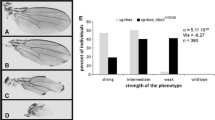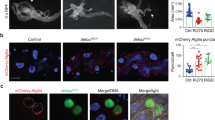Abstract
In Drosophila, cell survival decisions are mediated by the integrated functions of the Grim-Reaper death activators and Inhibitor-of-Apoptosis-Proteins (IAPs), such as DIAP1, to regulate caspase activities. We recently identified a gene that enhances the actions of the Grim-Reaper proteins and negatively regulates the levels of DIAP1 protein. This gene, morgue, encodes a novel protein that contains both an F box and a ubiquitin conjugase domain. Interestingly, the Morgue conjugase domain lacks the active site cysteine required for covalent linkage to ubiquitin. Morgue could target IAPs and other proteins for ubiquitination and proteasome-dependent turnover by acting either in an SCF ubiquitin E3 ligase complex, or as a ubiquitin E2 conjugase enzyme variant (UEV) in conjunction with a catalytically active E2 conjugase. Morgue is evolutionarily conserved, as a Morgue ortholog was identified from the mosquito, Anopheles gambiae. Elucidation of morgue function should provide novel insights into the mechanisms of ubiquitination and programmed cell death.
Similar content being viewed by others
References
Rudin CM, Thompson CB. Apoptosis and disease: Regulation and clinical relevance of programmed cell death. Annu Rev Med 1997; 48: 267–281.
Bellamy CO, Malcomson RD, Harrison DJ, Wyllie AH. Cell death in health and disease: The biology and regulation of apoptosis. Semin Cancer Biol 1995; 6: 3–16.
Thompson CB. Apoptosis in the pathogenesis and treatment of disease. Science 1995; 267: 1456–1462.
Glickman MH, Ciechanover A. The ubiquitin-proteasome proteolytic pathway: Destruction for the sake of construction. Physiol Rev 2002; 82: 373–428.
Pickart CM. Mechanisms underlying ubiquitination. Annu Rev Biochem 2001; 70: 503–533.
Hershko A, Ciechanover A. The ubiquitin system. Annu Rev Biochem 1998; 67: 425–479.
Grimm LM, Osborne BA. Apoptosis and the proteasome. Results Probl Cell Differ 1999; 23: 209–228.
Orlowski RZ. The role of the ubiquitin-proteasome pathway in apoptosis. Cell Death Differ 1999; 6: 303–313.
Wojcik C. Proteasomes in apoptosis: Villains or guardians? Cell Mol Life Sci 1999; 56: 908–917.
Lorick KL, Jensen JP, Fang S, Ong AM, Hatakeyama S, Weissman AM. RING fingers mediate ubiquitin-conjugating enzyme (E2)-dependent ubiquitination. Proc Natl Acad Sci USA 1999; 96: 11364–11369.
Suzuki Y, Nakabayashi Y, Takahashi R. Ubiquitin-protein ligase activity of X-linked inhibitor of apoptosis protein promotes proteasomal degradation of caspase-3 and enhances its antiapoptotic effect in Fas-induced cell death. Proc Natl Acad Sci USA 2001; 98: 8662–8667.
Yang Y, Fang S, Jensen JP, Weissman AM, Ashwell JD. Ubiquitin protein ligase activity of IAPs and their degradation in proteasomes in response to apoptotic stimuli. Science 2000; 288: 874–877.
Hengartner MO. The biochemistry of apoptosis. Nature 2000; 407: 770–776.
Salvesen GS, Dixit VM. Caspase activation: The inducedproximity model. Proc Natl Acad Sci USA 1999; 96: 10964–10967.
Thornberry NA, Lazebnik Y. Caspases: Enemies within. Science 1998; 281: 1312–1316.
Crook NE, Clem RJ, Miller LK. An apoptosis-inhibiting baculovirus gene with a zinc finger-like motif. J Virol 1993; 67: 2168–2174.
Verhagen AM, Coulson EJ, Vaux DL. Inhibitor of apoptosis proteins and their relatives: IAPs and other BIRPs. Genome Biol 2001; 2: Reviews3009.
Miller LK. An exegesis of IAPs: Salvation and surprises from BIR motifs. Trends Cell Biol 1999; 9: 323–328.
Deveraux QL, Reed JC. IAP family proteins-suppressors of apoptosis. Genes Dev 1999; 13: 239–352.
Hay BA. Understanding IAP function and regulation: A view from Drosophila. Cell Death Differ 2000; 7: 1045–1056.
Peterson C, Carney GE, Taylor BJ, White K. reaper is required for neuroblast apoptosis during Drosophila development. Development 2002; 129: 1467–1476.
Zhou L, Schnitzler A, Agapite J, Schwartz LM, Steller H, Nambu JR. Cooperative functions of the reaper and head involution defective genes in the programmed cell death of Drosophila central nervous system midline cells. Proc Natl Acad Sci USA 1997; 94: 5131–5136.
Chen P, Nordstrom W, Gish B, Abrams JM. grim, a novel cell death gene in Drosophila. Genes Dev 1996; 10: 1773–1782.
Grether ME, Abrams JM, Agapite J, White K, Steller H. The head involution defective gene of Drosophila melanogaster functions in programmed cell death. Genes Dev 1995; 9: 1694–1708.
White K, Grether ME, Abrams JM, Young L, Farrell K, Steller H. Genetic control of programmed cell death in Drosophila. Science 1994; 264: 677–683.
Srinivasula SM, Datta P, Kobayashi M, et al. sickle, a novel Drosophila death gene in the reaper/hid/grim region, encodes an IAP-inhibitory protein. Curr Biol 2002; 12: 125–130.
Wu JW, Cocina AE, Chai J, Hay BA, Shi Y. Structural analysis of a functional DIAP1 fragment bound to grim and hid peptides. Mol Cell 2001; 8: 95–104.
Goyal L, McCall K, Agapite J, Hartwieg E, Steller H. Induction of apoptosis by Drosophila reaper, hid and grim through inhibition of IAP function. EMBO J 2000; 19: 589–597.
Lisi S, Mazzon I, White K. Diverse domains of THREAD/DIAP1 are required to inhibit apoptosis induced by REAPER and HID in Drosophila. Genetics 2000; 154: 669–678.
Wang SL, Hawkins CJ, Yoo SJ, Muller HA, Hay BA. The Drosophila caspase inhibitor DIAP1 is essential for cell survival and is negatively regulated by HID. Cell 1999; 98: 453–463.
Wilson R, Goyal L, Ditzel M, et al. The DIAP1 RING finger mediates ubiquitination of Dronc and is indispensable for regulating apoptosis. Nat Cell Biol 2002; 4: 445–450.
Du C, Fang M, Li Y, Li L, Wang X. Smac, a mitochondrial protein that promotes cytochrome c-dependent caspase activation by eliminating IAP inhibition. Cell 2000; 102: 33–42.
Verhagen AM, Ekert PG, Pakusch M, et al. Identification of DIABLO, a mammalian protein that promotes apoptosis by binding to and antagonizing IAP proteins. Cell 2000; 102: 43–53.
Srinivasula SM, Hegde R, Saleh A, et al. A conserved XIAP-interaction motif in caspase-9 and Smac/DIABLO regulates caspase activity and apoptosis. Nature 2001; 410: 112–116.
Liu Z, Sun C, Olejniczak ET, et al. Structural basis for binding of Smac/DIABLO to the XIAP BIR3 domain. Nature 2000; 408: 1004–1008.
Wu G, Chai J, Suber TL, et al. Structural basis of IAP recognition by Smac/DIABLO. Nature 2000; 408: 1008–1012.
Hays R, Wickline L, Cagan R. Morgue mediates apoptosis in the Drosophila melanogaster retina by promoting degradation of DIAP1. Nat Cell Biol 2002; 4: 425–431.
Wing JP, Schreader BA, Yokokura T, et al. Drosophila Morgue is an F box/ubiquitin conjugase domain protein important for grim-reaper mediated apoptosis. Nat Cell Biol 2002; 4: 451–456.
Bangs P, White K. Regulation and execution of apoptosis during Drosophila development. Dev Dyn 2000; 218: 68–79.
Vernooy SY, Copeland J, Ghaboosi N, Griffin EE, Yoo SJ, Hay BA. Cell death regulation in Drosophila: Conservation of mechanism and unique insights. J Cell Biol 2000; 150: F69–76.
Abrams JM. An emerging blueprint for apoptosis in Drosophila. Trends Cell Biol 1999; 9: 435–440.
Brodsky MH, Nordstrom W, Tsang G, Kwan E, Rubin GM, Abrams JM. Drosophila p53 binds a damage response element at the reaper locus. Cell 2000; 101: 103–113.
Jiang C, Lamblin AF, Steller H, Thummel CS. A steroid-triggered transcriptional hierarchy controls salivary gland cell death during Drosophila metamorphosis. Mol Cell 2000; 5: 445–455.
Lohmann I, McGinnis N, Bodmer M, McGinnis W. The Drosophila Hox gene deformed sculpts head morphology via direct regulation of the apoptosis activator reaper. Cell 2002; 110: 457–466.
Kurada P, White K. Ras promotes cell survival in Drosophila by downregulating hid expression. Cell 1998; 95: 319–329.
Claridge-Chang A, Wijnen H, Naef F, Boothroyd C, Rajewsky N, Young MW. Circadian regulation of gene expression systems in the Drosophila head. Neuron 2001; 32: 657–671.
Panda S, Hogenesch JB, Kay SA. Circadian rhythms from flies to human. Nature 2002; 417: 329–335.
Young MW, Kay SA. Time zones: A comparative genetics of circadian clocks. Nat Rev Genet 2001; 2: 702–715.
Jin J, Harper JW. RING finger specificity in SCF-driven protein destruction. Dev Cell 2002; 2: 685–687.
Kipreos ET, Pagano M. The F-box protein family. Genome Biol 2000; 1: Reviews3002.
Patton EE, Willems AR, Tyers M. Combinatorial control in ubiquitin-dependent proteolysis: Don’t Skp the F-box hypothesis. Trends Genet 1998; 14: 236–243.
Zheng N, Schulman BA, Song L, et al. Structure of the Cul1-Rbx1-Skp1-F boxSkp2 SCF ubiquitin ligase complex. Nature 2002; 416: 703–709.
Sancho E, Vila MR, Sanchez-Pulido L, et al. Role of UEV-1, an inactive variant of the E2 ubiquitin-conjugating enzymes, in in vitro differentiation and cell cycle behavior of HT-29-M6 intestinal mucosecretory cells. Mol Cell Biol 1998; 18: 576–589.
Xiao W, Lin SL, Broomfield S, Chow BL, Wei YF. The products of the yeast MMS2 and two human homologs (hMMS2 and CROC-1) define a structurally and functionally conserved Ubc-like protein family. Nucleic Acids Res 1998; 26: 3908–3914.
Bailly V, Lamb J, Sung P, Prakash S, Prakash L. Specific complex formation between yeast RAD6 and RAD18 proteins: A potential mechanism for targeting RAD6 ubiquitin-conjugating activity to DNA damage sites. Genes Dev 1994; 8: 811–820.
Sung P, Prakash S, Prakash L. Stable ester conjugate between the Saccharomyces cerevisiae RAD6 protein and ubiquitin has no biological activity. J Mol Biol 1991; 221: 745–749.
Hoege C, Pfander B, Moldovan GL, Pyrowolakis G, Jentsch S. RAD6-dependent DNA repair is linked to modification of PCNA by ubiquitin and SUMO. Nature 2002; 419: 135–141.
Ryoo HD, Bergmann A, Gonen H, Ciechanover A, Steller H. Regulation of Drosophila IAP1 degradation and apoptosis by reaper and ubcD1. Nat Cell Biol 2002; 4: 432–438.
Zheng N, Wang P, Jeffrey PD, Pavletich NP. Structure of a c-Cbl-UbcH7 complex: RING domain function in ubiquitinprotein ligases. Cell 2000; 102: 533–539.
Zdobnov EM, Von Mering C, Letunic I, et al. Comparative genome and proteome analysis of Anopheles gambiae and Drosophila melanogaster. Science 2002; 298: 149–159.
Holt RA, Subramanian GM, Halpern A, et al. The Genome sequence of the malaria mosquito Anopheles gambiae. Science 2002; 298: 129–149.
Holley CL, Olson MR, Colon-Ramos DA, Kornbluth S. Reaper eliminates IAP proteins through stimulated IAP degradation and generalized translational inhibition. Nat Cell Biol 2002; 4: 439–444.
Yoo SJ, Huh JR, Muro I, et al. Hid, Rpr and Grim negatively regulate DIAP1 levels through distinct mechanisms. Nat Cell Biol 2002; 4: 416–424.
Vernooy SY, Chow V, Su J. Drosophila bruce can potently suppress rpr-and grim-dependent but not hid-dependent cell death. Curr Biol 2002; 12: 1164–1168.
Olson MR, Holley CL, Yoo SJ, et al. Reaper is regulated by IAP-mediated ubiquitination. J Biol Chem 2003; 278: 4028–4034.
MacFarlane M, Merrison W, Bratton SB, Cohen GM. Proteasome-mediated degradation of Smac during apoptosis: XIAP promotes Smac ubiquitination in vitro. J Biol Chem 2002; 277: 36611–36616.
Author information
Authors and Affiliations
Rights and permissions
About this article
Cite this article
Schreader, B.A., Wang, Y. & Nambu, J.R. Drosophila morgue and the intersection between protein ubiquitination and programmed cell death. Apoptosis 8, 129–139 (2003). https://doi.org/10.1023/A:1022914524601
Issue Date:
DOI: https://doi.org/10.1023/A:1022914524601




